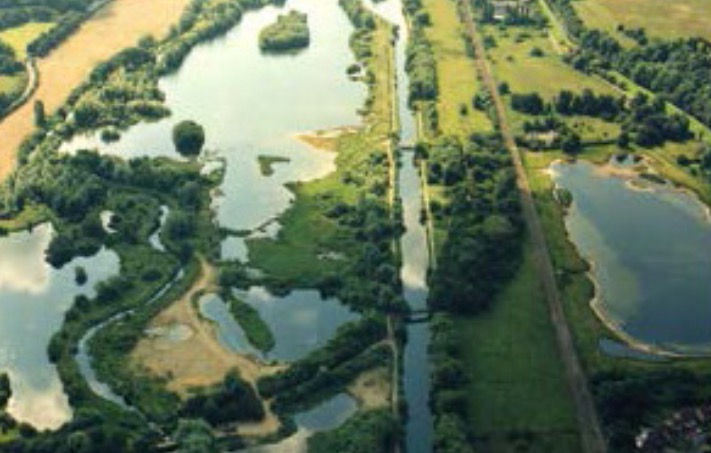Amwell Nature Reserve
Former CEMEX gravel pits have been restored to create a diverse wetland nature reserve of international importance for conservation. Now the Amwell Nature Reserve in Hertfordshire, UK, the site attracts rare wintering water birds and 19 species of dragonfly and damselfly.

The diverse wetland habitats of Amwell Nature Reserve
Rare species found at Amwell Nature Reserve:
- 19 species of dragonfly and damselfly
- Otters
- Shoveler ducks
"What has been created at Amwell is rich in wildlife, a place of great beauty and hope, a place that uplifts the spirit; it is indeed one of the great cathedrals of nature."
Tom Gladwin, a well known local naturalist who was instrumental in establishing Amwell Nature Reserve.
CEMEX relies on raw materials such as sand and gravel to make its cement and concrete products. These are essential for building the roads, schools and homes that society needs, but quarrying the materials has the potential to degrade habitats and damage species unless the land is carefully managed. We are determined to have a positive impact on nature by promoting a diverse range of habitats and species while quarries are active, and by rehabilitating disused sites. By restoring former quarry sites we also provide communities with new nature reserves and education and leisure facilities.
Amwell Nature Reserve is an example of a quarry we have successfully rehabilitated. Between 1973 and 1990, we extracted two million tonnes of sand and gravel from the Lee Valley site, much of which was used to construct the M11 and M25 motorways. After quarrying ceased in 1990, we began to restore the gravel pits to create a diverse wetland nature reserve. The reserve is now part of a chain of wetland sites that stretches for 27 miles through the Lee Valley Regional Park to the River Thames, and it forms part of the Lee Valley Special Protection Area.
Since quarrying ended, the landscape has been carefully managed so that habitats can develop naturally. Early restoration work at the site earned Amwell the Cooper Heyman Trophy, a restoration award from the Sand and Gravel Association now the Mineral Products Association. Since then, we have transformed the 43 hectare site into lakes, reed beds, marsh and woodland. The reserve is now designated as a Site of Special Scientific Interest (SSSI).
The Hertfordshire and Middlesex Wildlife Trust has managed the Amwell Nature Reserve since 2003, and in 2006 they purchased the site. The trust has since invested £1 million in habitat restoration and improved facilities to attract visitors to the reserve. Together, we have built three bird watching hides and five special viewpoints providing panoramic views of the upper Lee Valley. As part of the restoration, we imported ash from a nearby power station and this supports a colony of marsh orchids . In 2008, the Trust constructed a 70-metre long dragonfly trail that helps visitors get up close to the reserve's 19 species of dragonfly and damselfly.
More than 20 years of restoration have transformed this old quarry into an important nature reserve. Significant numbers of wintering gadwall and shoveler ducks use the reserve as a safe haven, while the lakes and their shores attract breeding birds including the little grebe, kingfisher and oystercatcher. All known species of dragonfly and damselfly have been recorded and the diversity of the wetland habitat supports a wide range of plants, such as the scarce marsh dock. The Amwell Nature reserve is also home to otters, which were reintroduced to the region in 1991.
The reserve is an important visitor attraction, especially for birdwatchers. In 2009, around 97,000 people visited the site, many of whom came to see the panoramic views from the elevated viewpoint.
The Hertfordshire and Middlesex Wildlife Trust manages the reserve through an advisory group with representatives from the Environment Agency, Lee Valley Regional Park Authority, Hertfordshire Natural History Society, the Amwell Magna Fishery and local volunteers. The Trust has three main aims for the Reserve. Firstly, they want to maintain the ecological diversity of the reserve so it continues to support a range of species. Secondly, the Trust will promote the growth of species at neighbouring sites. And finally, they will continue to improve facilities so birdwatchers and other visitors can enjoy the wildlife.
With help from experts at the Royal Society for the Protection of Birds (RSPB), CEMEX UK has developed an ambitious ten-year biodiversity strategy. This sets challenging targets, including our goal to create and maintain, by 2020, 1,000 hectares of habitats identified by the UK Government as conservation priorities.
For more information please contact us or visit the wildlife trust website here.
